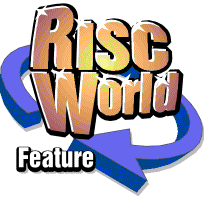



WebFX3D
RISCWorld presents the WebFX3D Manual.
| Introduction |
WebFX3D is relatively easy-to-use 3D graphics software, which allows you to create 3D text images.
WebFX3D can help create stunning publications. Whether you are working on a web page, presentation, report or project, WebFX3D will enhance your work.
Objects created in WebFX3D can be rendered and saved as an image of any size and colour (memory permitting), with simulated anti-aliasing to give web pages and on-screen presentations sub-pixel accuracy.
WebFX3D can also export the 3D object in VRML format. This can be viewed by most web browsers in 3D. Additionally objects could be loaded into 3D CAD software to form part of larger scenes.
Web site developers can also create animations in the form of a sprite file containing one image for each frame. These can be loaded by other software (ie. InterGif 6) to create animating images for the internet etc.
See Also:
About this Manual
Terminology
| About this Manual |
For a full list of the contents of this manual, view the Contents Page (click the top left icon of this window).
This manual is divided into the following sections:
Introduction to WebFX3D
An overview of WebFX3D, its uses and terminology.
Getting started
Covers the installation of WebFX3D on your computer, system requirements, how to run WebFX3D and use Online Help.
Creating Objects
How to create objects in WebFX3D, using draw files and Add-ons.
Working with a 3D scene
How to work with your 3D objects. Topics include the 3D display, options, plug-ins, atmosphere, the gallery and exporting.
Lighting
Explains how to use lighting in your scene by looking at light positioning, colours, ambient lighting and attenuation.
Rendering
How to create final rendered images of your scene. Topics include basic settings, animations and filters.
Reference
Various topics relating to WebFX3D, including the 3D co-ordinate system, light colours, and the WebFX3D colour picker.
Hints and Tips, Troubleshooting
Helpful information to help you get the best out of WebFX3D, and to solve common problems, answer questions.
See Also:
Terminology
Introduction
| Terminology |
The following is a description of terminology used in this manual.
VRML; Abbreviation for Virtual Reality Modelling Language . This is a standard file format for describing 3D scenes.
Scene; Everything which forms a 3D environment, including objects, lights, atmosphere, background etc.
Object; A distinct 3D entity, or group of entities. Whatever is in the 3D view is an object.
Mesh; 3D objects are made up of meshes. In WebFX3D, each mesh is a series of triangles.
True Colour; Refers to 24bit colour quality.
Mask; Transparency. Sprite images can hold additional transparency information. When a sprite is shown, its transparency mask is used to determine which pixels you see. Those which are masked allow the background behind the sprite to show.
Co-ordinates; In common with other 3D systems, WebFX3D shows 3D measurements in the form of XYZ co-ordinates. See the reference section for details.
Rendition, Render; Creating a bitmap image of a 3D scene. WebFX3D renders the Render objects in a 3D scene in such a way, that they look 3D, even though being represented on a 2D image.
Join; The part of a 3D object which joins the front face to the back.
Controls; Items in a window which do something (i.e. radio buttons, option buttons, the close icon etc.)
Tabs; A new control which allows a window to show several sets of options in limited space.
See Also:
Introduction
About this Manual
RISCWorld